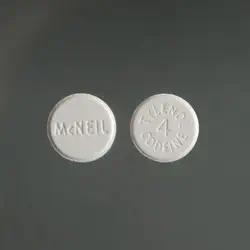DRUGS: WHAT YOU
NEED TO KNOW Booklet

Signs and Symptoms of Codeine Addiction

Codeine is a commonly-used medication for treating coughs, pain and diarrhea. It is derived from opium and while it is not as strong or dangerous as heroin or oxycodone, there is a risk of addiction or overdose if it is abused.
Abuse means that a person uses more than prescribed, uses it without a prescription or uses it in a different way than recommended. This could mean that they take a higher dosage, crush pills and snort the powder, or dissolve pills and inject the liquid.
Codeine in Liquid Form
Codeine also comes as a liquid used as a cough suppressant. Codeine to be used for coughs is often formulated as a combination of drugs, so this formulation may also contain an antihistamine, expectorant or decongestant. In liquid or pill forms, its formulation very often includes other drugs.
If a person is abusing a cough medication, it is very easy to keep drinking that liquid until they experience the euphoric effects of the opioid. If they drink too much, however, they can overdose. Even though codeine is a weak painkiller, it is possible to fatally overdose.
Codeine in Pill Form

Courtesy of DEA.gov
When this drug is prescribed for pain, it is often combined with acetaminophen and administered as a pill. Alternately, it may be combined with paracetamol and ibuprofen.
In some countries, codeine formulas are still available over the counter. In America, as recently as 2018, codeine was still available over the counter in some states.1
As noted in an article published on the JAMA Network Open, codeine prescriptions for young patients have frequently been associated with abuse and addiction in adolescents.2 Efforts to restrict prescriptions to children under 18, announced in 2017 and 2018, have reduced the number of prescriptions issued to young patients and the resulting harm.
A person being prescribed cough medication or a mild pain reliever may not even know it contains codeine. These prescription medications have codeine as an ingredient:
- Fioricet with codeine
- Promethazine with codeine cough syrup
- Robitussin A-C
- Triacin-C
- Tuzistra XR
- Tylenol with codeine #3
American Abuse of Opioids
The Substance Abuse and Mental Health Services Administration (SAMHSA) tracks how many people abuse and are addicted to opioids like codeine.3 In 2020, more than nine million people misused prescription pain relievers of all types. Nearly a million of these individuals abused a medication containing codeine.
Of those nine million people, 2.3 million suffered from a substance use disorder to a prescription opioid. That’s SAMHSA’s way of stating that these people were struggling with addiction.
Physical Signs of Codeine Addiction

Codeine is an opioid, which means the signs and symptoms of codeine addiction will be similar to those of addiction to hydrocodone, oxycodone, and even heroin. A person misusing or addicted to codeine can show these signs:
- nausea
- vomiting
- constipation
- sedation
- itching
- blurred vision
- difficulty urinating
- tremors
- abdominal pain
Behavioral and Mental Signs of Codeine Addiction
Opioids have a sedative effect, which means that people will think and react more slowly when they are under the influence. Here are the behavioral and mental signs that may be seen in a person addicted to codeine:
- decreased interest in sex
- clouded thinking
- depression
- anxiety
Once a person is addicted, there is normally a deterioration in the quality of their life. Their focus is more on making sure they have the drugs they need for the next day than on their health or their family. Addiction generates a compulsive attitude about their drug use and other matters tend to fall by the wayside. Job performance, school grades and relationships all begin to suffer.
It is also common for a person addicted to prescription opioids to begin running into legal problems or to start suffering from health problems. Sometimes families can’t figure out what is happening to a loved one that shows these signs but if they add up the behavioral changes with the physical signs of codeine addiction, they may get their answer.
The Long-Term Harm of Codeine Addiction

The long-term consumption of opioids of any type can be hard on the body. A person addicted to codeine who does not get help may suffer these harmful effects:4
- intestinal blockages
- poor lung function
- kidney damage
- liver damage
- hormonal disruption
- impotence
- infertility
- osteoporosis
- sleep problems
Codeine Overdose
A person experiencing an overdose of codeine will show these signs:
- bluish fingertips and lips
- clammy skin
- labored breathing
- confusion
- loss of consciousness
- low blood pressure
- weak pulse
- tiny pupils
Like with any other opioids, a codeine overdose can be fatal if enough of the drug is consumed. Codeine is a weaker drug than oxycodone or heroin, but a fatal overdose is still possible. First responders normally carry a drug called naloxone which is an antidote to an opioid overdose. The first thing to do if signs of a codeine overdose are seen is to call for emergency services.
Withdrawal from Codeine
If a person has been consuming a medication that contains codeine for several weeks or longer, it is likely that they will experience withdrawal symptoms when they quit. These symptoms may include:
- enlarged pupils
- irritability
- restlessness
- anxiety
- runny nose
- insomnia
- yawning
- chills
- rapid heartbeat
- vomiting
- diarrhea
- stomach and muscle cramps
- muscle pain
These symptoms are essentially the same as the symptoms of withdrawal from any opioid, including heroin or hydrocodone.
One of the dangers of taking codeine for a long period for women is that a mother taking this medication during pregnancy can cause her baby to struggle after its birth.5 When the baby is born, it no longer receives a dose of codeine through the mother. It may suffer from neonatal abstinence syndrome, with symptoms like these:
- irritability
- high-pitched, inconsolable crying
- poor sleep patterns
- shaking
- vomiting
- diarrhea
- lack of weight gain
The baby may need to be weaned off the drug gradually which means a stay in the hospital until they are comfortable and are feeding and sleeping normally.
Recovery from Codeine Addiction
With the right support and care, it is possible to recover from codeine addiction. The stigma associated with misuse of opioids and addiction may cause some people to hesitate to ask for help. Families may be reluctant to admit that a loved one is addicted to an opioid or they may be too angry to offer help.
The right thing to do is to find effective rehabilitation for a loved one who is addicted to codeine. It is possible to recover from codeine addiction and to once again become the person who was left behind when codeine took over.
Sources:
-
Food and Drug Administration. “FDA Drug Safety Communication: FDA requires labeling changes for prescription opioid cough and cold medicines.” FDA, 2018. FDA Article ↩︎
-
JAMA Network Open. “Prescriptions for Codeine or Hydrocodone Cough and Cold Medications to US Children and Adolescents Following US Food and Drug Administration Safety Communications.” JAMA Network Open, 2021. JAMA Network Open Research Letter ↩︎
-
SAMHSA. “Key Substance Use and Mental Health Indicators in the United States: Results from the 2020 National Survey on Drug Use and Health.” Substance Abuse and Mental Health, 2021. SAMHSA Article ↩︎
-
National Center for Biotechnology Information. “A Review of Potential Adverse Effects of Long-Term Opioid Therapy.” NCBI, 2012. NCBI Article ↩︎
-
MedlinePlus. “Codeine.” MedlinePlus, 2022. MedlinePlus. MedlinePlus Article ↩︎


